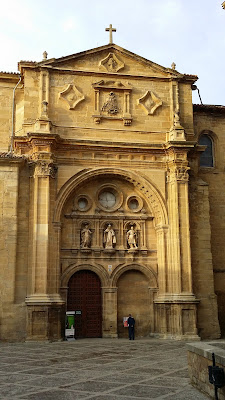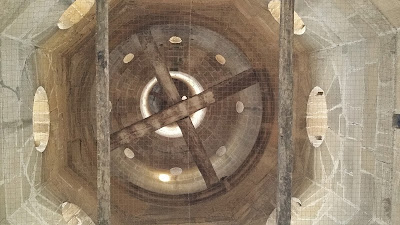 |
| The bell tower of Santo Domingo Cathedral |
Bidding auf wiedersehen to our German admirers we finally set off in the light rain. I had not slept that well the night before for two reasons. Firstly my mum was having an operation on her shoulder back in Ireland that morning and I was worried about her and how she would cope. But secondly, I was still thinking of the slump that I had the previous day at the roundabout and the interminable walk downhill to Berceo in the rain and that hill had built up into a major physical and psychological barrier in my fitful dreams during the night that had to be scaled to get back to the Camino. I trudged out of San Millán with slight trepidation, steeling myself for the ordeal before me.
 |
| Halfway to Santo Domingo |
 |
| David powering towards Ciruena |
We decided to celebrate with a sandwich, in what looked from the outside, a very unprepossessing cafe called Bar Jacobeo. But never judge a book by it's cover - outward appearances can be deceptive! We stepped inside and the first thing I noticed was that there were several local extended families dining - always a good sign to see locals eating in a bar I feel. The second thing I noticed was that two policemen were also eating. My dad always used to say that if you see policemen eating in a cafe it is always a good sign that the food is good!
 |
| Bar Jacobeo |
 |
| The superlative paella! |
 |
| Squid in ink sauce |
 |
| Flan |
 |
| David walking towards Santo Domingo |
Because we were some of the last to arrive there were few beds left so I let the elderly David (!) have the only remaining ground floor bunk and I had a second level bunk beneath a plywood slanted ceiling. I made note to self, not to sit up suddenly during the night or I would smack my head on same!
The bathroom was also cramped and the floor was flooded as other pilgrims had already done their ablutions and as there was nowhere to hang clothes whilst showering it was hard to keep things dry. I had been spoilt by the albergue at Logroño and our guesthouse at San Millán and I could feel myself getting irritated, but I reminded myself that this was not the right attitude and that on the Camino I should accept each day as it comes and try not to complain.
David and I were particularly keen to wash some clothes but checking around in the back garden we found that there were no washing machines and tumble driers and as it was too cold to dry clothes on a line, I decided to reluctantly shelve the idea until I got to Belorado.
 |
| Palace of the Marquis of Fuerte Hijar |
 |
| Dog in Plaza Santo |
 |
| Artist's impression of the early development of Santo Domingo de la Calzada |
 |
| Portal of Cathedral |
 |
| Inside the Hermitage Chapel |
 |
| David on top of the bell tower |
 |
| View up inside of bell tower |
 |
| Looking towards Belorado from Bell tower |
 |
| Bell tower graffiti |
A fine renaissance gilded retable by Damian Forment dating from 1537 - 40, with an impressive silver altar has been moved into a chapel on the north side so as not to obscure the ambulatory.
 |
| Apse |
 |
| Apse carving detail |
 |
| King David |
 |
| Tomb of Santo Domingo |
 |
| Detail of Scenes from the Passion of Christ on wall of Santo Domingo's tomb |
 |
| Gothic canopy over Santo Domingo's tomb |
Near
the mausoleum on the west wall of the south transept is a late gothic carved
niche with a renaissance grille behind which is a cage containing a pair of
live white chickens – a cockerel and a hen! This structure is called the Gallinero or Chicken Coop of Santo Domingo. The tradition of keeping chickens in
the cathedral is linked to the most famous miracle associated with Santo
Domingo. There are as usual, various versions of the story but basically, it is
said that in the 14th Century an 18 year old German pilgrim called
Hugonell from the Diocese of Cologne was on pilgrimage with his parents and stayed
in an inn in Santo Domingo. The innkeeper’s daughter made sexual advances to
Hugonell, who refused them. The spurned girl was filled with anger and hid a
silver cup in Hugonell’s bag to get revenge and then informed the town
authorities that Hugonell had taken it. Hugonell was sentenced to death and hanged.
As his grief stricken parents were preparing to leave they heard their son’s
voice telling them that he was still alive as Santo Domingo himself was holding
him up by the feet. They rushed to the house of the town judge who was just
sitting down to a dinner of two roast chickens, a cock and a hen, and told him
their story. The judge scoffed at them and replied that their son was no more
alive than the chickens on his plate whereupon they jumped up miraculously from
his plate complete with feathers and began to flutter around proving the boy’s
innocence! |
| Altar of Santo Domingo |
 |
| The Gallinero |
 |
| The holy chickens! |
 |
| Playmobile Advert |
 |
| Playmobile flagellation of Christ |
 |
| Playmobile Via Dolorosa |
 |
| Tang Dynasty artefacts |
 |
| Song Dynasty Porcelain |
 |
| Tomb in Cathedral |

No comments:
Post a Comment